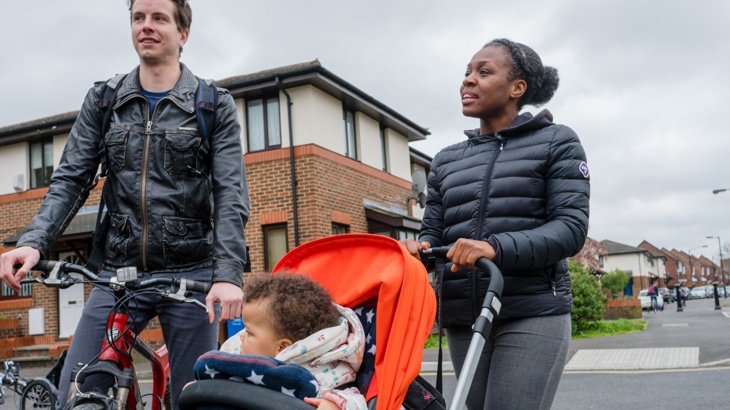Megan Streb was formerly a Partnerships Manager at Sustrans and is now Head of Outreach at the What Works Centre for Local Economic Growth. Her research informed our recent report - Walkable neighbourhoods: building in the right places to reduce car dependency. Here Megan explains the findings of her research and why distance to local services is a crucial component in enabling people to walk their everyday journeys.

The importance of being able to walk our everyday journeys is recognised by all. Credit: photojB
Walking is important; everyone says so
From the Government’s documents – the National Planning Policy Framework and Decarbonising Transport – to the Chief Medical Officers’ Guidance and individual local authorities’ policies, all agree on the importance of creating places that make it easier for people to walk.
And when I spoke to local authority planning officers, they told me that they want to put development near existing services in walkable places.
“Connectivity is just a general good practice, you know. You don't really design things to be to be inaccessible,” one officer told me.
And yet, we’re facing both a decline in walking rates since 2002(1) and regular criticism that we’re creating less walkable places(2).
It’s a matter of distance
So, what’s gone wrong?
How can we – politicians, academics and professionals - see how important walking is, yet build neighbourhoods that don’t allow people to choose what should be the most accessible form of everyday transport?
Much of the problem is around distance.
If everyday destinations are nearby, people will walk.
The National Travel Survey showed that for trips under a mile, 80% are walked, rather than driven or made by any other transport mode.
Analysis of that data showed that of those walking trips, 50% were under 800m.
New developments can have tree-lined pavements, dropped kerbs and safe crossings, but if they’re not near shops, schools, and services for everyday trips, people don’t have much of a reason – or option - to walk.

We should be ensuring that children can walk to school rather than forcing families to drive.
Walkable neighbourhoods: building in the right places to reduce car dependency
The Sustrans report, Walkable Neighbourhoods: building in the right places to reduce car dependency, builds on my research asking local planning authorities how they currently consider proximity to shops and services when allocating sites for development in their Local Plans.
With the recognised importance of walking, you might not be surprised to hear that 90% of respondents do look at proximity to at least one facility (a GP’s surgery or a bus stop for example).
But you probably will be surprised to hear that the councils I heard from use 22 different figures for what is considered an ‘acceptable maximum’ distance to those services.
And half of those are distances over 800m (what’s considered to be a 10 minute walk).
Not only that, but most of the councils would not turn down a development site simply because it was too far away from local services and amenities.
What this means in practice is that we are knowingly building developments that lock-in car dependency.
We know that people will not be able to walk to the things that they need, and we build there anyway.
Why are we still building car-dependent neighbourhoods?
There are many reasons for this happening. One is a lack of set guidelines in national planning policy.
That means that a local authority team may not know that studies show that 800m is how far a majority of people will walk.
Or local authorities may set 800m as the upper limit to build from services and amenities, but then don’t specify that the distance must be measured using the pavement network rather than as the crow flies. This often leads to many people having to travel further.
Or they may set 800m as the limit of a ‘very good’ score, leaving further and further distances to be considered ‘good’ ‘acceptable’ or ‘poor’ distances from shops or schools.
Many authorities I spoke to worried that developers would cry foul if stronger local policy on walkable distances wasn’t clearly supported by national policy.
Another reason development sites end up being allocated too far from amenities and services is pressure from housing targets.
Officers I spoke to feel constrained by housing targets, feeling that they can’t turn down sites that are not accessible by walking and still meet their targets.
What needs to change?
The report includes a number of recommendations, many based on good practice that local planning authorities are already doing.
But the survey results, as well as interviews I carried out with council officers, point to the need for clarity from the UK Government.
If walking - and its positive impact on public health, levelling-up and the climate emergency - are important, the process for prioritising walking needs to be set out in national planning policy.
Read the report – Walkable neighbourhoods: building in the right places to reduce car dependency.
References
- National Travel Survey, excluding a lockdown cabin fever boost to trips over 1+ mile in 2020.
- Transport for New Homes, 2018; Place Alliance National Housing Design Audit, 2020; RTPI Location of Development, 2018 and 2021.





